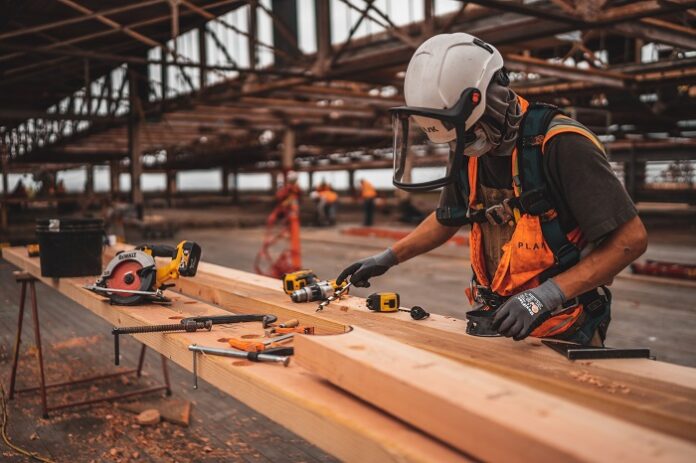It is found that 1 of 5 deaths of workers is from the construction industry. This stat states the lack of safety in construction sites.
So, if your business is all about construction worksites or you’re the manager of one, it’s high time you pick smart improvements and value your workers’ lives.
And if you’re wondering how follow through with these steps!
1. Make digital plans and designs
Collect accurate site data through laser scanning, LiDAR, and drone surveys. This data can be used to create an accurate 3D model of the site, helping to identify potential challenges and opportunities.
Incorporate VR and AR technologies to visualize the project in immersive ways. These technologies can aid in design reviews, identifying clashes, and improving overall project understanding.
Consider the project’s lifecycle by analyzing environmental impacts, energy consumption, and maintenance costs to make informed design decisions.
Continuously update the digital model throughout the construction process to reflect any changes, ensuring that the physical work aligns with the original design intent.
2. Monitor from remote
Deploy cameras and sensors across the worksite to capture real-time video footage, images, and data. These can monitor equipment, workers, and overall progress.
Set up a robust and secure network infrastructure, including high-speed internet and VPN connections, to ensure reliable data transmission from the worksite to a remote location.
Enable authorized personnel, such as project managers and supervisors, to access the cloud platform remotely from their devices, providing them with a live feed of the worksite.
In real-time, remote access monitors construction activities, worker movements, equipment usage, and project progress.
Configure the system to send automated alerts and notifications to remote personnel in case of critical events, deviations from plans, or safety concerns.
3. Provide wearable technology
Equip workers with wearable devices that monitor vital signs, body temperature, and fatigue levels. These wearables alert supervisors if a worker’s health is compromised, ensuring prompt assistance.
Provide workers with helmets with augmented reality (AR) visors that display relevant information, such as blueprints, safety guidelines, and real-time project updates.
Use wearable GPS trackers or badges to monitor workers’ locations on the worksite, ensuring efficient allocation of resources and enhancing safety during emergencies.
Implement biometric wearables, like fingerprint or iris scanners, to ensure secure access control to restricted areas and equipment.
Provide workers with wearable communication devices, such as smartwatches or earpieces, for real-time communication, reducing.
Ensure workers are informed about the data collected by wearables and obtain consent. Address any privacy concerns and clearly define how the data will be used.
4. Invest in automation and robotics
Determine repetitive, labor-intensive, or hazardous tasks that can be automated or performed by robots. This might include tasks like concrete pouring or material transportation.
You can invest in Veyor Digital’s construction site logistics software for added assistance. It offers logistic services, crane scheduling, loading docks, and driver tracking for various industries like construction, distribution, and event management.
Integrate robots and automated machinery that can perform specific tasks precisely and quickly, like robotic arms for welding and 3D printing for construction.
Develop or customize the software to program and control the robotic equipment. This includes defining tasks, paths, and parameters for each operation.
Implement autonomous or semi-autonomous vehicles and drones for transporting materials and tools around the worksite, reducing the need for manual labor. For example, partnering with a competent concrete pump hire company with quality equipment for concrete pouring or pump operation can ensure that your construction project runs smoothly, efficiently, safe, and on time.
Apply safety protocols and barriers to prevent accidents when humans work alongside robots or automated equipment.
5. Look for energy efficiency way
Install LED lighting with occupancy sensors and daylight harvesting to reduce electricity usage when spaces are unoccupied or natural light is available.
Improve insulation, sealing, and windows to minimize heat loss or gain and enhance indoor comfort.
Use energy-efficient machinery and appliances that meet industry standards for low energy consumption. Implement power management systems to control and reduce the standby power consumption of devices and equipment.
Set timers and schedules for equipment operation to match actual usage patterns. Explore government incentives, tax credits, and green building certifications that promote energy efficiency.
Conclusion
Remember, each construction site is unique, so personalize these steps to fit your project’s specific needs and goals. Incorporate these to transform your construction worksite into a more innovative and efficient environment.
You’ll optimize resource allocation, enhance safety, and reduce costs by embracing digital planning, remote monitoring, wearable technology, automation, and energy efficiency.
Through these strategies, you’ll create a smarter, safer, and more productive construction worksite that sets new standards for excellence.





